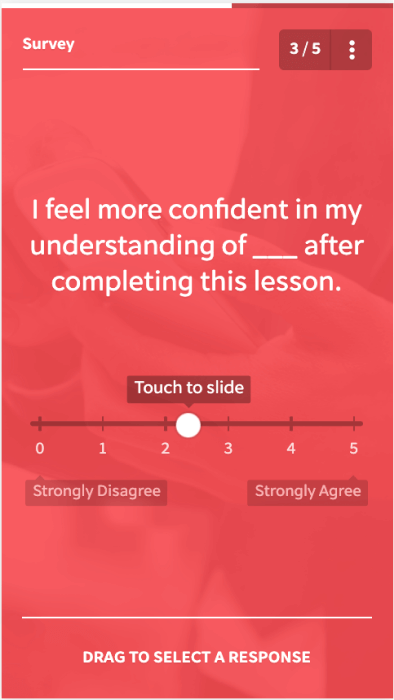Training Effectiveness Evaluation Form

One of the best ways to find out if you’re getting your money’s worth from your training programs and your trainers are with a training effectiveness evaluation form.
The importance of evaluating your training
A recent article made a very strong case for the continued importance of workplace training and learning and development. Yet, not just any training—high quality, extremely relevant training (HQERT). (Get ready for a lot of numbers!)

Would your organization like to increase your rate of employee retention? The stats show that your employee retention can grow by 30–50% of your training program is HQERT. (Consider that 40% of resignations are due to employee frustrations with workplace training and learning experience.)
A super high 94% of employees reported that company training causes them to stick with that workplace longer. This makes sense given that 68% of workers surveyed felt that the most important workplace policy was training competency and development and knowledge and skills possibilities—even more important to millennials (87%). In case you are not keeping track, millennials are currently between the ages of 26-and 41. That might be a large chunk of your workforce. Employee development is so important that 70% of those surveyed “would be tempted” to move to another workplace that offers such opportunities as employee training programs and corporate training.
Is a higher profit margin something your management would be interested in? Companies with HQERT programs enjoy a 24% higher profit margin on average.
Given the two huge plusses of training, incredibly, not all workplaces offer HQERT. More than half (56%) of employees surveyed said they had not gotten “any formal training” for their current position. Only 12% of workers report that they manage to use “knowledge acquired through training” while on the job. They explain that this is because the training and training materials they did receive were not relevant to their position.
Even worse, the annual cost of ineffective training is a staggering 3.5 million per 1000 employees on average. That’s 3,500 per employee/learner. Try adding that figure to your employee’s salary to see how much you are ACTUALLY paying them.
It’s almost like: “Forget sales and service! Just by improving training, organizations can make significant improvements in their balance sheets.”
Of course, HQERT will improve your sales and service, too, but you get my point.
A note about HQERT
Providing high-quality, extremely relevant training (HQERT) is not that difficult, especially when using a learning management system (LMS) such as EdApp.
One tip is to make sure that your trainees review the material often. Spaced repetition features such as Brain Boost and Rapid Refresh do this automatically. No excuses that anyone “forgot”.

Another tip is staying on top of trainee progress and completion. Often, training courses are good, but trainee completion rates are low. Analytics such as Actionable Reports give you the data you need as well as options to remind your trainees to get going (in the nicest way, of course).
How to successfully evaluate your training
When you sell your product or service, you give your customers some type of “customer satisfaction” follow-up, right? In contemporary practice, this often involves conducting an online survey facilitated by the use of an online form-maker.
Well, like it or not, your employees are your customers. You are, in fact, “selling” them your company. They are free to shop around and get better deals. They will do this if they feel that your “product” does not meet enough of their needs.

With regard to your workplace training evaluation, your workers are the people whose opinions are the most important. So, just like your real customers, you need to give your employees some type of “worker training satisfaction” follow-up. A training effectiveness evaluation form is the right tool for this job.
Components of a training effectiveness evaluation form
The layout of the form should reflect your company’s culture, goals, and design aesthetic. The actual questions on your form will vary depending on the training. The rating scale I prefer is: Strongly agree, Agree, Neutral, Disagree, Strongly disagree. Of course, you are free to use the rating scale of your choice.
Following are the basic components, with sample questions, presented in alphabetical order.
Anonymity
Keeping feedback anonymous does two important things. First, it allows your employees to give honest and full responses without worrying about negative repercussions (outcomes). Second, it presents the feedback in a non-biased way as possible since the reader does not know personal details about the trainee.
As a result, your feedback form should be online. In this way, handwriting cannot give any clues as to identity.
If you wish, you can have trainee identification as an option. Yet, it should not be a must.
Course identification
The recommended suggestion is to create a separate training effectiveness evaluation form for each training course. This allows you to ask specific questions to pinpoint the aspects of each training program.
If you choose to use one standard form, you will need to have a section that identifies to which course this feedback belongs. Dropdown menus can help ensure identification accuracy. I suggest one menu of course names; another menu of dates; and a third of facilitators/mentors. With three distinct menus, you can check that the data matches up, identifying the training correctly.
Facilitator/Trainer
This section evaluates whoever was running the course. If your training is some type of internal training, there will be an obvious presenter, supervisor, training manager, or facilitator. Even if your training is based on a microlearning platform, there should still be someone from human-resources that’s responsible for overseeing progress, competencies, and troubleshooting difficulties.
Here are some sample feedback statements:
- The facilitator/trainer was knowledgeable about the course content.
- The facilitator/trainer was well prepared.
- The facilitator/trainer presented the material in a variety of attention-grabbing ways.
- It was easy to get clarification from the facilitator/trainer when needed.
- I felt the facilitator/trainer got to know my individual learning needs.
- I felt the facilitator/trainer was aware of my progress.
Materials and course content
Let’s get right to the possible feedback statements because there are lots:
- The course content was relevant to my current job.
- The material covered increases my chances of future promotion.
- The flow and organization of the course contributed to my learning.
- Overall, the pace of the course was good for me.
- In general, the amount of material was right for me.
- The course content was not too complex (difficult) or too simple (easy) for me.
- The course materials supported the course objectives.
- The online training material was easy to access.
- I had enough time to complete all the required modules.
- Feedback during the course contributed to my learning.
- The course had features that motivated me to complete the requirements.
- I could easily track my progress.
- The online nature of this course suited my learning style. -or- The classroom nature of this course suited my learning style.
Objectives
Strangely, many training programs have lots of content, but no one is sure what the exact objectives are. This is because they were built “bottom-up."
When we create learning material via a “top-down” approach, we must focus on the objectives first. The “bottom-up” method focuses on the content first. People usually begin with the material they already have. As a result, objectives can get totally forgotten. Another outcome is that there are objectives, but they are made to fit the existing content. This often means that these objectives are not the objectives that really need to be addressed (and for which new content would need to be created). This approach is a lot better for measuring the effectiveness of training and makes creating the training evaluation form much simpler.
These feedback statement ideas can help check this out:
- The course objectives were clearly defined.
- The facilitator/trainer went over the course objectives.
- The course objectives were achieved via the course materials.
- Trainees were involved in setting the course objectives.
- The course objectives were relevant to my current workplace needs.
Overall feedback
Provide text entry boxes for additional comments. Your trainees can type in their comments. You may wish to offer a general comment box, allowing whatever feedback your workers wish to enter. On the other hand, you may wish to guide their feedback. For example, boxes for:
- Specific strengths/weaknesses of the facilitator/trainer
- Suggestions for improving the course content & materials
- Feedback to make the objectives more relevant
You might not have the resources to create such long forms—although elearning authoring tools make this a virtual snap.
No problem. Here’s a simple idea for any training feedback form for trainees that's also quite effective. At the end of a course or lesson, have a short, 2-item feedback opportunity. When using an online learning management system (LMS) such as EdApp, this would look like two additional slides at the end of your course. One slide asks your trainees how the information has improved their understanding of the topic. The other slide accepts typed-in suggestions for improvement.
Author
